Running even a single good puzzle in your D&D adventure is not easy. You need to come up with a puzzle that fits the story, is engaging, and is above all, well-designed.
A lot of time can go into setting up just one puzzle. But when you’re running a D&D puzzle adventure you’re managing multiple puzzles. An average puzzle adventure usually contains about 5 to 7 puzzles.
Running puzzle adventures can be a huge time sink and there’s a lot that can go wrong unless you have a plan. So here’s our tried and tested plan for running D&D puzzle adventures like nobody’s business.
1. Choose the Right Puzzles
Designing and illustrating your own custom puzzles is probably the biggest time suck in the history of D&D. There are so many details and considerations that go into creating a good puzzle. You could well spend two hours or more on a puzzle that players solve in minutes.
Now consider having to come up with 5 puzzle designs AND a story that logically connects all of them. If you have to do all of that work yourself, you’ll probably spend over 20 hours on your puzzle adventure.
We don’t even bother creating our own puzzles. For 5 bucks you can get a heap of professionally designed premade puzzles that come fully illustrated and are easy to adapt to just about any story.
So let’s say you get a premade pack of puzzles. We’ll choose Lock Puzzles for this example. It comes with just 9 puzzle locks that each holds 3 key pieces. But by combining those locks you can create up to 500 different puzzles.
Lock Puzzles can be dropped onto any object you wish to lock. A door is an obvious choice but you can also lock a wizard’s tome, treasure chest, or anything else you can think of really.
2. Lay Out Your Puzzles
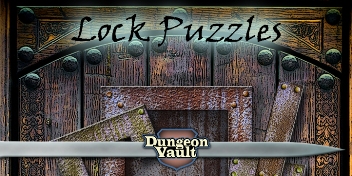
The second step to running a great D&D puzzle adventure is to lay out your puzzles in a way where solving one puzzle will lead to the clues or key pieces needed to solve the next puzzle. You can do this by layering puzzles. Here’s how you do that:
For our adventure example, the PCs are doing a dungeon crawl. They enter the first room of the dungeon which is scattered with skeletons who have fallen in battle. And there are two doors. The left door holds a single puzzle lock and the right door holds two such locks.
The PCs search the bodies and find 5 key pieces. Since each puzzle lock holds only 3 pieces, they have enough pieces to open the left door. But the right door holds two puzzle locks and needs a total of 6 pieces to open.
The players manage to use the puzzle pieces to open the left door and enter a small kitchen. Hidden behind the stove is the sixth key piece. They head back to the right door and use the six pieces to open this door.
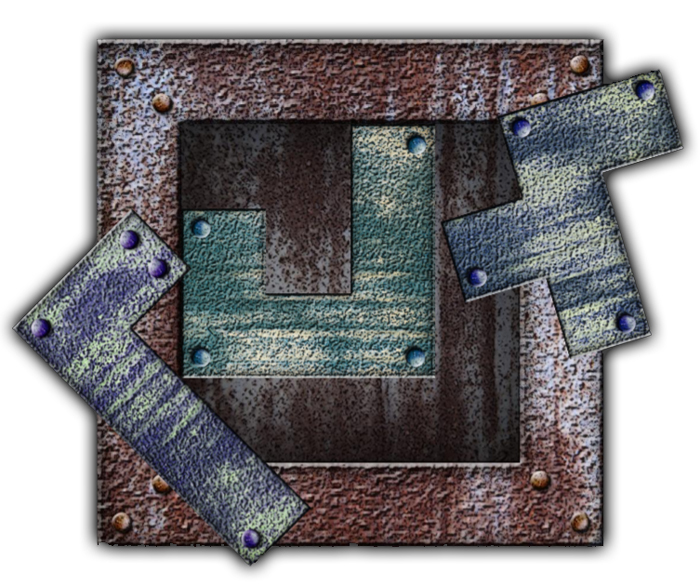
Players had to first solve the left door puzzle before they were able to obtain all the key pieces for solving the right door puzzle. All you need to do to create such a setup is hide a single piece behind a locked door.
You can create some very complicated strings of puzzles with this technique. And they don’t have to be linear. Our affiliate who designed this puzzle actually has an insightful article on how to layer door puzzles effectively on their website.
3. Make your Puzzles Progressively Harder
Another thing we wanted to illustrate with this example is how the first puzzle was really easy. Fitting just three key pieces into a puzzle lock requires no explanation. But the second door held two puzzle locks. And while there are many ways to fill out one lock, there’s only one way to fill out two.
For the third door, you could use three puzzle locks. And the final lock could hold as many as nine locks. That challenge takes the average group of players about 20 minutes to solve.
YOU MAY ALSO LIKE:
- Learn how to Run Combat Puzzles in Dungeons & Dragons
- Running Outdoor D&D Puzzles
- Running D&D Puzzles in a Dungeon
4. Add a Story to your D&D Puzzle Adventure
By using the lock puzzles you can easily layout a string of puzzles for players to solve. And a dungeon crawl is probably the easiest way to control how players explore your story. But once you have the basic structure down of how puzzles are connected in your adventure, you can start to make things more interesting.
If you know the order in which PCs will explore rooms, you can add chapters of your story to each room. Maybe players discover in the first room that the skeletons belong to dwarves from the same clan who turned on each other. The natural question players will ask is why loyal clan dwarves would turn on each other?
The next room is the kitchen and here the players find a vial still smelling of hallucinogenic mushrooms. That might explain the dwarves’ erratic behavior. But who could have slipped the toxin into their food and why?
With each room, you can create a situation that begs the next question. And this leads PCs further into your story. Of course, not every new chapter needs to lie behind a door. PCs could encounter a greedy goblin who will fight them for key pieces. You can stick key pieces to the ceiling and have players climb up to reach them. This is where you let your imagination run free to add some variety.
Another way to add more variety to your D&D adventure is by switching out a few lock puzzles for other types of puzzles. In our webshop, we have a range of puzzles that work very well in almost any adventure.
Also, the puzzle doesn’t have to be located on a door. You can place them on the end boss just as easily. What if the boss at the end of your dungeon were a Copper Dragon and players need to place all the key pieces on its body to defeat it? Here’s an article we wrote about how to use puzzles in combat.
Perfect D&D Puzzle Adventures
Variaty is the spice of life and that’s certainly true for puzzle adventures. Your adventures will be more fun if you mix it up. So here are some puzzles that you can combine easily to create the perfect puzzle adventure:
Door Puzzles
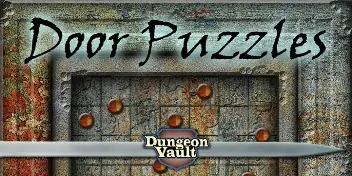
Door Puzzles can be placed onto any door to instantly change it into a challenging puzzle. You simply pick a puzzle from the stack of 20 premade setups, hand your players the key pieces and sit back while they solve the challenge. Of all the puzzles we’ve seen this one is among the easiest for DMs to setup. Door puzzles comes in printable and VTT format.
The rules are simple. Each puzzle door has a grid and a number of pegs. Players must place the key pieces over the pegs to fill out the grid. Sounds simple enough right? But the hard part is that players get ALL the key pieces to choose from. And selecting the right combination requires a lot of logical reasoning.
We found door puzzles has a nice flow of discoveries. And players can work at solving it simultaneously. You can also view this puzzle from all sides which comes in very handy if your players are sitting around the table. Finally, you can create your own puzzles with this system. So you can create an infinite amount of puzzles if you wish.
All the mentioned puzzles and many more are in the Puzzle Bundle. So be sure to check it out!
Dungeon Puzzles
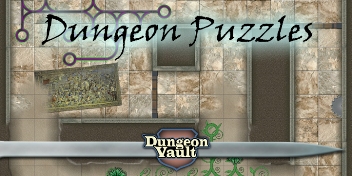
Dungeon Puzzles can change your entire dungeon into one big puzzle. Hallways, rooms, crossroads, and so on all become pieces of the puzzle. While players are laying out this puzzle and solving it, they are also creating the dungeon map you can immediately play on!
But that’s not all. This the Dungeon Puzzles pack also contains cave pieces and more puzzle pieces that you can place inside your dungeon or cave. Puzzles within puzzles.
Another highlight of Dungeon Puzzles is that all players can work at solving the puzzle at the same time. And it doesn’t matter which side of the table you are sitting on because the puzzle pieces can be viewed from all sides.
While the pack comes with 25 premade puzzles, you can create an infinite amount of puzzles and dungeon layouts. And there’s no limit to the size of your puzzle setups. It’s really a complete puzzle system. The pieces come in VTT and printable format. This pack offers a crazy amount of value for money.
Potion Puzzles
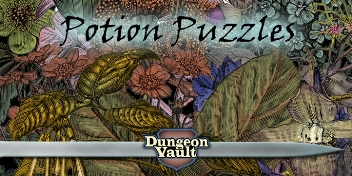
Potion Puzzles took us by surprise. We were expecting a series of simple potion themed puzzles. What we got was a puzzle system that can also double as a complete system for creating magical items in your world. But you don’t have to. Potion Puzzles gives you all the creative control as a DM while adding a massive amount of flavour.
Collecting ingredients, finding potion formulas, and brewing perfumes, dyes, polishes, inks, and of course potions are all a part of solving the puzzle. You can sprinkle ingredients and formulas throughout your campaign. When your players manage to solve the puzzle, create their very own potion and use it, it’s much more significant to the story.
Magical inks can be used for scrolls, dyes for creating magical robes and so on. In short, we got more with this potion puzzles then we thought possible with such an elegant system.
Dark Ulf is the founder and editor of DNDpuzzles.com. When not writing for DNDpuzzles he travels the multiverse and destroys demons with a crossbow in one hand and a crossword in the other.
We hope this site inspires you to put more puzzles into your D&D games.



